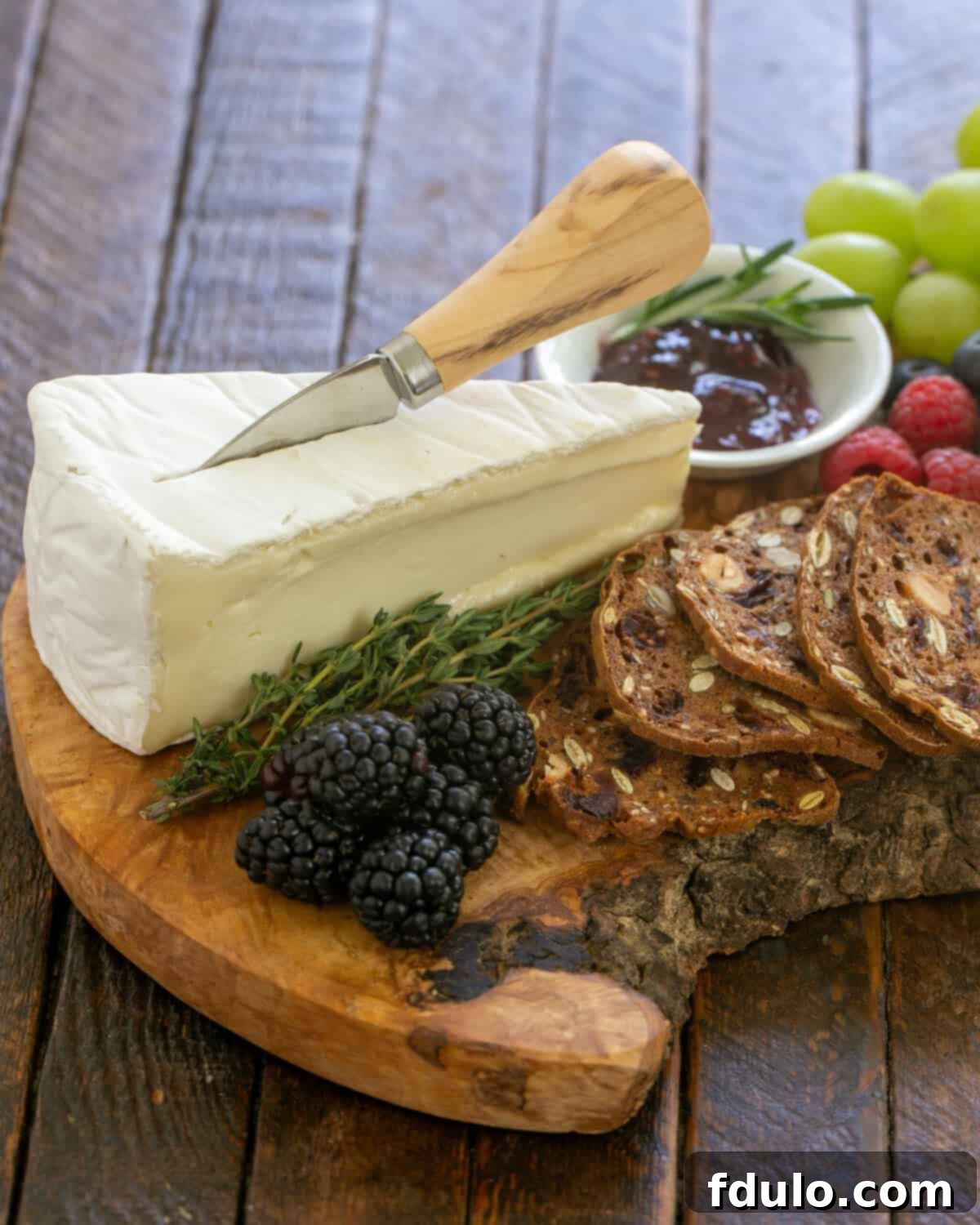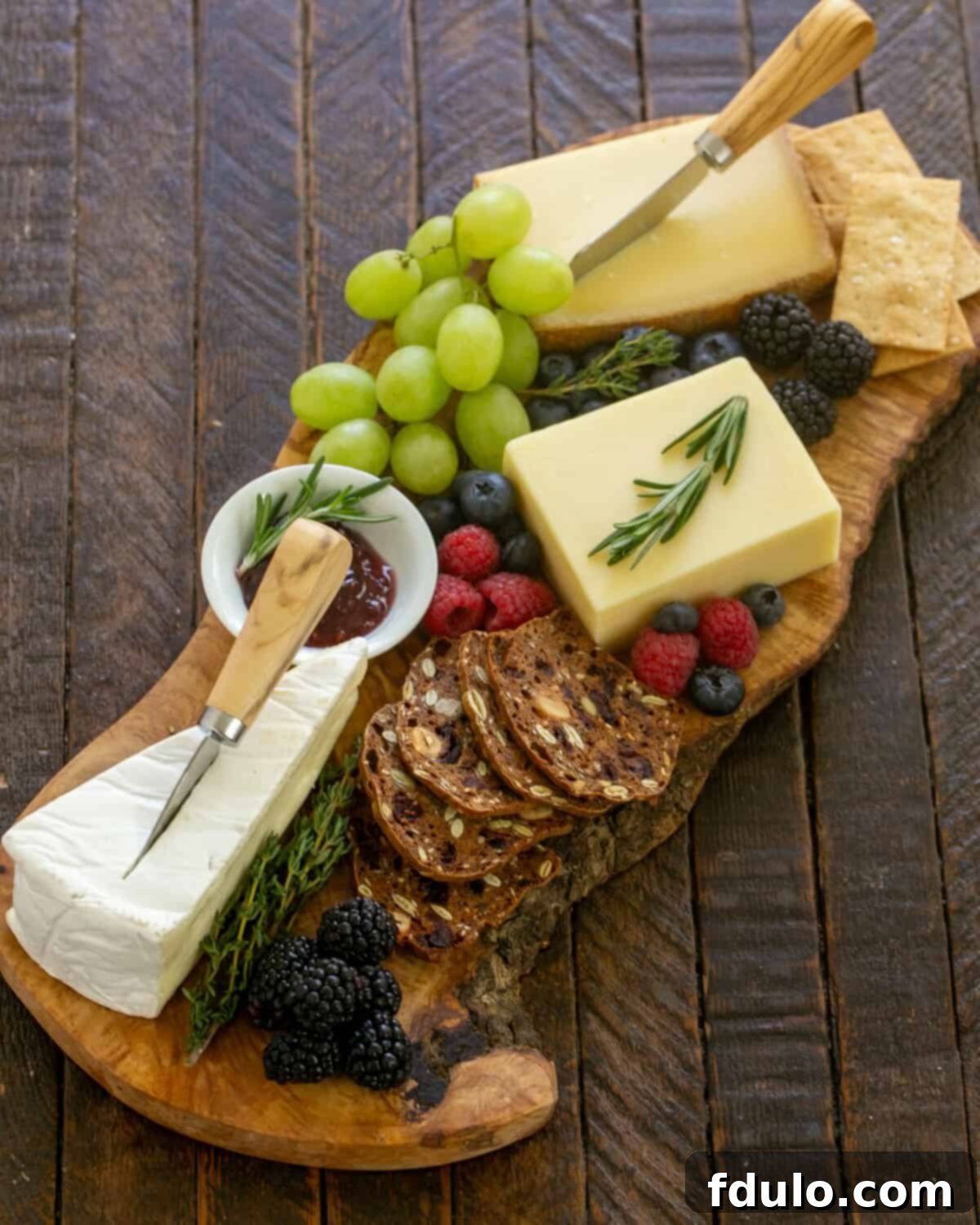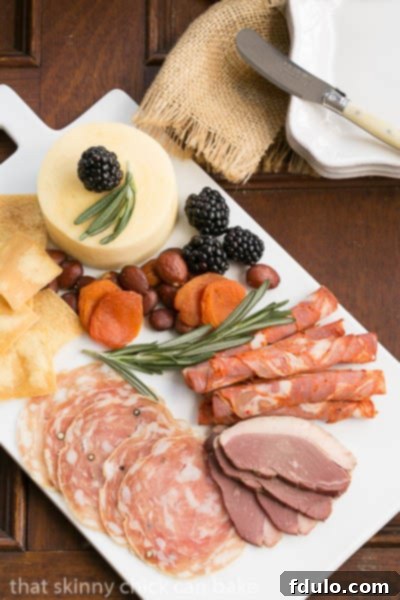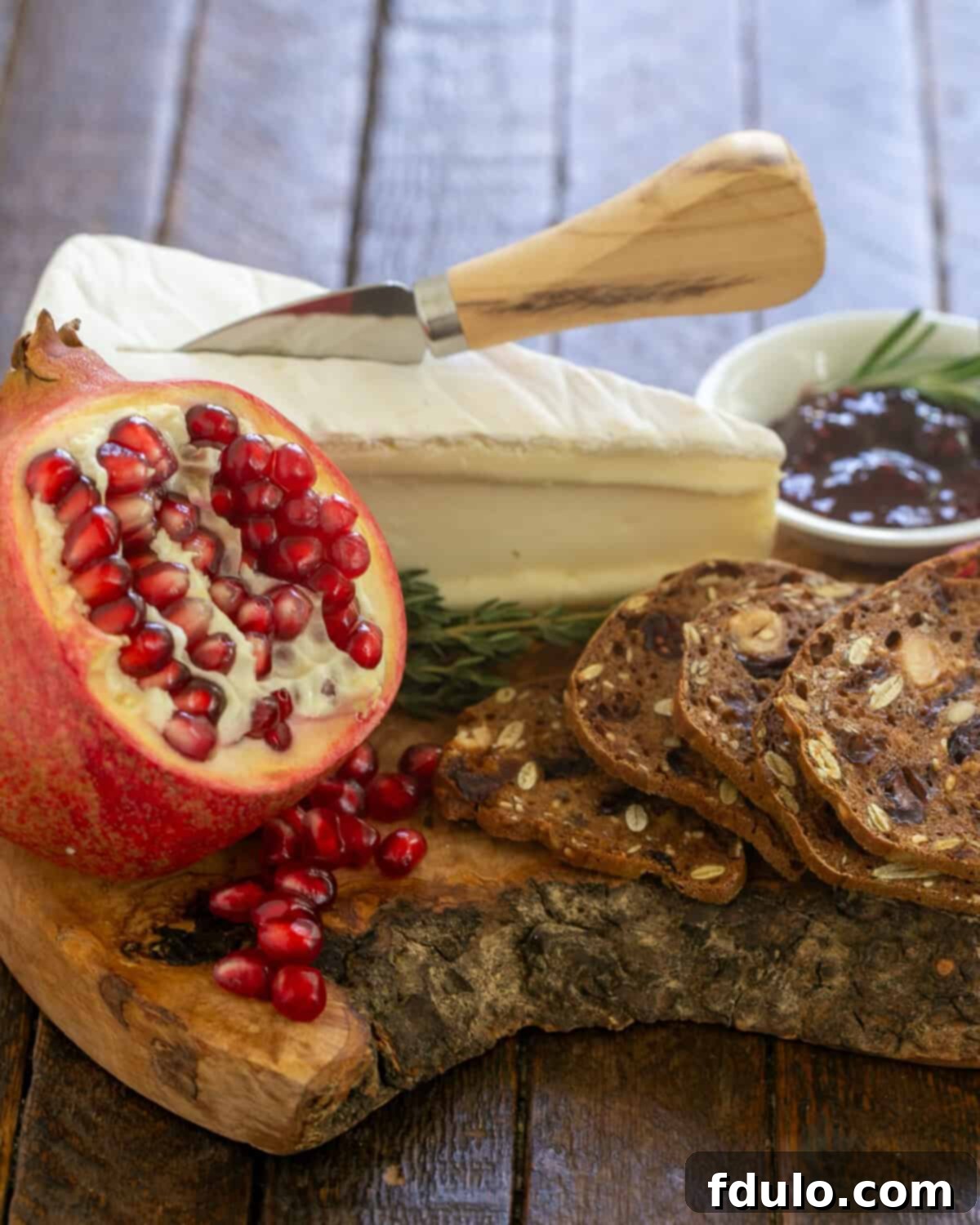Discover the art of creating a captivating Charcuterie Platter that combines an exquisite selection of cured meats, artisanal cheeses, crunchy nuts, and fresh fruits, designed to delight every palate. Few culinary experiences rival the simple elegance and communal joy of sharing a beautifully curated cheese board before a meal.
A Cheese Board is inherently versatile and adaptable, making it the perfect centerpiece for any gathering. Its design can seamlessly align with the theme of your event or the seasonality of your ingredients. Planning a French-inspired dinner? Opt for classic French cheeses. Celebrating autumn? Incorporate seasonal bounty like crisp apples, juicy pears, and toasted pecans. Each board you craft will be distinctively unique, a reflection of your favorite flavors and personal touch.

Why a Charcuterie Platter is a Must-Have for Your Next Gathering
The allure of a charcuterie board extends beyond its aesthetic appeal; it offers a multitude of practical benefits that make it an indispensable choice for entertaining. Here’s why this versatile platter should be at the top of your hosting list:
- Unmatched Customization: A basic cheese or charcuterie board serves as a blank canvas, allowing you to tailor it precisely to your preferences. Select your favorite meats, cheeses, fresh and dried fruits, crunchy crackers, and an array of savory snacks. This ensures every guest finds something they love, from the adventurous eater to those with more classic tastes. You can even cater to specific dietary needs or preferences by including gluten-free crackers or vegetarian options.
- Seamless Theme Coordination: Elevate your entertaining by designing a charcuterie board that perfectly complements your meal’s theme or a holiday celebration. Imagine a vibrant summer board with fresh berries and light cheeses, or a cozy winter platter featuring robust aged cheeses, spiced nuts, and rich fig jam. For festive occasions like Christmas, themed boards, such as a delightful Santa Charcuterie Board, add an extra layer of fun and charm.
- Effortless Entertaining for Any Crowd: One of the greatest advantages of a charcuterie tray is its scalability. Whether you’re hosting an intimate dinner for two or a grand holiday party for dozens, the concept easily expands. Simply increase the quantity and variety of ingredients, or use a larger board to accommodate more guests, making it an ideal solution for stress-free holiday entertaining.
- A Simple Alternative to Multiple Appetizers: Instead of spending precious time preparing several individual appetizers, creating a magnificent charcuterie board offers a refreshing and efficient alternative. Deck out a generously sized cutting board with an irresistible combination of savory meats, creamy cheeses, and delightful accompaniments. This single, stunning display creates an immediate “wow” factor with minimal fuss.
- Guaranteed Crowd-Pleaser: A charcuterie board truly offers something for everyone. From salty meats and tangy pickles to sweet fruits and mild cheeses, the diverse selection ensures that every guest, regardless of their palate, will find a delicious bite to enjoy. It encourages mingling and conversation as guests explore the various offerings.
Crafting Your Perfect Charcuterie Board: A Step-by-Step Guide
Creating an impressive charcuterie board is an art form that’s surprisingly easy to master. Follow these steps to build a visually stunning and delicious spread:
- Start with the Foundation: Cheeses, then Meats, and finally, Accompaniments. For a purely cheese-centric board, you can omit the meats entirely. However, for a true charcuterie experience, cured meats are essential.
- PRO-Tip: Selecting Your Cheeses. Aim for an odd number of cheeses – three or five varieties often look most appealing and offer good diversity. Strive for a range of textures and flavors:
- Firm Cheese: Options like aged Cheddar, Gruyère, or Swiss provide a satisfying bite.
- Soft Cheese: A creamy Brie, Camembert, or a fresh chèvre (goat cheese) adds a luxurious, spreadable element.
- Fragrant/Bold Cheese: Introduce a blue cheese (like Roquefort or Gorgonzola) for a pungent kick, or a flavored cheese like a cranberry cheddar or an herbed goat cheese for an interesting twist.
- Unexpected Delights: Don’t shy away from unique finds! A crowd-pleaser like Kerrygold’s Dubliner with Irish Stout offers a robust flavor profile that appeals to many. Consider adding a sheep’s milk cheese or a semi-hard cheese like Manchego for further variety.
Allow your cheeses to rest at room temperature for at least an hour before serving to enhance their flavor and texture.
- Next, Curate Your Cured Meats. Ideally, select three distinct varieties of cured meats to offer a range of flavors and textures. Seek advice from experts at your local deli or specialty market, as they can provide excellent pairing suggestions. For example, consider:
- Spicy Salami: A thinly sliced Italian Toscano salami or Calabrian Capicola can add a delightful kick.
- Delicate Prosciutto: Known for its buttery texture and salty-sweet flavor, prosciutto is always a sophisticated choice.
- Smoked Duck Breast: For a gourmet touch, thinly sliced smoked duck breast offers a rich, unique flavor.
- Other Options: Coppa, soppressata, chorizo, or even a smooth pâté can also be excellent additions. Arrange them artfully by folding, rolling, or stacking to create visual interest.
Remember, while “charcuterie” traditionally refers to cured pork products, many modern boards incorporate other types of cured meats or even smoked fish for variety.
- Gather Your Savory and Sweet Accompaniments. These “odds and ends” fill out your board and provide balance to the rich meats and cheeses. Some excellent choices include:
- Nuts: Honeyed pecans, roasted Marcona almonds, pistachios, or walnuts add satisfying crunch.
- Fruits: Fresh blackberries, grapes, figs, apple slices, or pear wedges offer freshness. Dried apricots, cranberries, and dates provide concentrated sweetness and chewy texture.
- Breads & Crackers: Sardinian flatbread, artisan crackers, sliced baguette, or even crunchy breadsticks serve as vessels for your cheeses and meats. Offer a variety of textures, from crisp to chewy.
- Olives & Pickles: A small bowl of briny olives (Kalamata, Castelvetrano) or crisp cornichons and pickled onions cuts through the richness and cleanses the palate.
- Spreads: Jams, jellies, fruit pastes (like quince paste or fig spread), or a dollop of whole-grain mustard can beautifully complement both sweet and savory elements.
Utilize the knowledge of the experts at your favorite market, deli, or specialty shop. They are often delighted to offer samples and guide you in selecting a variety of ingredients that will truly delight your guests and possibly introduce you to a new favorite!
Recommended Amounts for Your Charcuterie Board
Determining the right quantities for your charcuterie board depends significantly on whether it’s serving as a light appetizer before a substantial meal or if it’s the main culinary event. These recommendations, often guided by culinary experts like America’s Test Kitchen, provide a helpful starting point:
- Cheeses: Aim for 2 to 3 ounces per person if serving as an appetizer. If the board is the meal, increase to 4 to 6 ounces per person. Offer a minimum of three varieties.
- Meats: Similar to cheese, allocate 2 to 3 ounces per person for an appetizer. For a main meal, plan for 4 to 6 ounces per person. Include at least three distinct types.
- Nuts: Approximately 2 to 3 tablespoons per person. A small handful provides just the right amount of crunch and richness.
- Crackers, Toasts, or Bread: Provide a generous 4 to 6 ounces per person. It’s always better to have too many than too few, as these are essential vehicles for the other ingredients.
- Fruit or Vegetables: Allocate 4 to 8 ounces per person. This category is highly flexible, allowing for more if you want a lighter, fresher board.
- Dips/Spreads: About ½ cup per person for jams, honey, or other spreads. Small bowls prevent cross-contamination and make dipping easy.
Remember, these are guidelines. Consider your guests’ appetites, the presence of other food, and the duration of your event when making your final selections.

Elevate Your Platter: Advanced Tips for a Stunning Charcuterie Display
Transforming a collection of ingredients into a feast for the eyes and the palate requires a few thoughtful touches. These expert tips will help you create a truly unforgettable charcuterie experience:
- Choose the Right Foundation: Begin by selecting the perfect base for your masterpiece. A beautiful wooden cutting board (olive wood or acacia are popular choices), an elegant unembellished ceramic tray, or a dedicated cheeseboard set complete with specialized knives will set the stage for your culinary creation. Consider the size and shape to ensure enough space for all your carefully chosen elements.
- Let the Stars Shine: The beauty of a charcuterie board lies in its focus on quality ingredients. Allow your carefully selected meats and cheeses to be the undeniable stars of the show. Complement them with plain, neutral crackers and crusty bread that won’t compete with or overpower their delicate flavors.
- Embrace Fresh and Dried Fruits: Fruits are not just for garnish; they offer crucial balance. Fresh fruits like crisp apples, juicy pears, plump figs, and sweet grapes pair wonderfully with a variety of cheeses, providing a refreshing counterpoint. Adding dried fruits such as apricots, cranberries, or dates introduces a delightful chewiness and concentrated sweetness, contributing to a rich array of textures.
- Add Crunch with Nuts: Nuts are indispensable for texture. Roasted Marcona almonds, candied pecans, walnuts, or pistachios provide a satisfying crunch that contrasts beautifully with soft cheeses and tender meats. Scatter them in small piles or fill empty spaces to add visual interest and flavor.
- Don’t Forget Flavorful Spreads: Jams, jellies, and fruit pastes are essential companions for cheese. Quince paste, fig jam, spicy pepper jelly, or a dollop of local honey can introduce a delightful sweetness or tang that elevates the entire tasting experience. These small, potent additions can highlight nuanced flavors in your cheeses.
- Vary Shapes, Colors, and Heights for Visual Appeal: A truly stunning platter engages the eye. Strategically arrange ingredients to create visual interest. Think about varying the shapes of your cheeses (wedges, rounds, cubes), the colors of your fruits and vegetables, and the heights of your elements (a small bowl of olives, a mound of folded prosciutto, a sprig of rosemary). This creates a dynamic and inviting presentation.
- Temperature Matters: For maximum flavor and optimal texture, allow your cheeses to rest at room temperature for at least an hour before serving. Cold cheese tends to be muted in flavor and firm in texture, whereas cheese served at room temperature will have a more pronounced aroma and a softer, more luxurious mouthfeel.
- Prioritize Texture and Flavor Diversity: As mentioned, aim for a wide variety. Include cheeses ranging from hard and crumbly to soft and buttery. Don’t shy away from a bold-flavored blue cheese or a spiced variety to add intrigue. Beyond cow’s milk, explore goat’s milk or sheep’s milk cheeses to introduce different flavor profiles and textures.
- Master the Artful Arrangement: Take a little extra time to artfully arrange your charcuterie platter. Instead of simply placing items, try layering meats, fanning crackers, creating small clusters of fruit, and filling any empty spaces with nuts or fresh herbs. This thoughtful approach transforms your board from a simple spread into a true culinary masterpiece, and you’ll be delighted with the results.
Frequently Asked Questions About Charcuterie Boards
The term “charcuterie” originates from 15th-century France. It literally translates to “products of a fancy pork butcher,” referring to a branch of cooking devoted to prepared meat products, primarily from pork, such as bacon, ham, sausage, terrines, and pâtés. Today, it broadly encompasses an elegant arrangement of these items, often paired with cheese and various accompaniments.
Charcuterie is pronounced “shar-KOO-tuhr-ee.” Mastering the pronunciation adds to the sophisticated enjoyment of your culinary creation!
The “3-3-3-3 Rule” is a popular guideline for building a balanced and varied charcuterie board. It suggests including: 3 kinds of cheese (e.g., one firm, one soft, one pungent); 3 types of meat (e.g., prosciutto, salami, pâté); 3 starches (e.g., crackers, bread, breadsticks); and 3 extras. The “extras” category is highly flexible and can include garnishes, jams, fruit paste, fresh fruit, fresh vegetables, olives, or fresh herbs, ensuring a comprehensive and appealing spread.
A general rule of thumb is to allow for approximately 3 ounces of total charcuterie ingredients (cheese and meat combined) per person if the board is a light appetizer. However, this can vary significantly. Consider factors such as whether other appetizers will be served, if a large meal will follow, the time of day, and if you know your guests have particularly hearty appetites. For the board serving as the main event, increase the total to 6-8 ounces per person.
While the final assembly is best done just before serving, many components can be prepared ahead of time. Cheeses can be sliced and meats arranged on parchment paper, then refrigerated. Fruits and vegetables can be washed and cut (toss apples/pears with a little lemon juice to prevent browning). Store all components separately and assemble them on the board no more than 1-2 hours before guests arrive to maintain freshness and prevent sogginess.
The wide array of flavors on a charcuterie board means many drinks can pair beautifully. For wine, consider a crisp Sauvignon Blanc, a light-bodied Pinot Noir, or a sparkling wine like Prosecco or Champagne. Craft beers, especially saisons or lighter IPAs, also complement charcuterie well. Non-alcoholic options like sparkling cider, artisanal sodas, or even a robust iced tea can be refreshing.

Photo circa 2014
Forest Decor Cheeseboard Giveaway
I instantly fell in love with the gorgeous olive wood cheeseboard and knife set pictured above when I first saw this Forest Decor Set in my photo. Their beautiful products are handmade with 100% olive or forest wood and are completely free of chemicals. They make fabulous gifts for any cook or entertainer in your life. Think ahead to birthdays, anniversaries, and Christmas!
I am delighted to offer a giveaway of this lovely Bamboo Cutting Board to one lucky reader! To enter, simply visit the Forest Decor Website to explore their exquisite collection of wooden cutting and serving boards. Then, return to this page and share your favorite cheeseboard from their selection in the comments below. Each comment counts as one entry into the giveaway. This giveaway is open only to residents of the 48 contiguous US states. The winner will be randomly selected using random.com on May 3, 2024. Good luck to everyone!
You May Also Like: Inspire Your Next Culinary Creation
- Easy Spring Charcuterie Board from Reluctant Entertainer
- Chocolate Dessert Board
- Triple Cheese Gougeres
- How to Arrange a Simple Cheese Tray
- Festive Blue Cheese Balls
- More Easy Appetizer Recipes
Stay in touch through social media @ Instagram, Facebook, and Pinterest. Don’t forget to tag me when you try one of my recipes! And if you love the results, please give it a 5-star rating in the recipe card.

How to Make a Cheese Board
15 minutes
15 minutes
Learn what to put on a cheese board and how to arrange it for a delightful presentation.
Ingredients
- A high-quality wooden cheese board or a large ceramic platter.
- 3 to 5 distinct cheeses, offering a variety of textures (hard, soft, semi-hard), pungency, shapes, and flavors. Odd numbers generally create a more balanced look.
- Assorted fresh fruits such as apples, pears, berries (e.g., blackberries, grapes). If slicing apples and pears ahead, lightly coat with lemon juice to prevent oxidation.
- Fresh herbs like rosemary or thyme sprigs for an aromatic and visual pop of green.
- A selection of condiments, including chutney, fruit jelly, savory jam, whole-grain mustard, and assorted olives.
- Various crackers, toasts, or slices of a fresh baguette to complement the cheeses and meats.
Instructions
- Select a suitable cheeseboard or platter that provides ample space for arranging your chosen cheeses, crackers, and all accompanying elements.
- Thoughtfully place at least 3 types of cheese on your board. Aim for an odd number for better visual balance. Ensure a good variety in texture, flavor, and shapes (e.g., wedges, logs, cubes) to create an engaging display.
- Artfully fill the remaining spaces on the board with fresh fruit, sprigs of fresh herbs, a selection of crackers, and small bowls of jam or other spreads. If you are creating a charcuterie board, now is the time to add your cured meats.
- Remove all cheeses from the refrigerator approximately one hour before you plan to serve. Allowing them to come closer to room temperature will soften their texture and significantly enhance their inherent flavors, offering a more enjoyable tasting experience for your guests.
Notes
Note: Remember, there are no strict rules when crafting your cheese board. Feel empowered to customize it entirely to your taste and preferences – make your cheese board YOUR way!
Recommended Products
As an Amazon Associate and member of other affiliate programs, I earn from qualifying purchases.
- Small white bowls
HOW MUCH DID YOU LOVE THIS RECIPE?
Please leave a comment on the blog or share a photo on Pinterest
